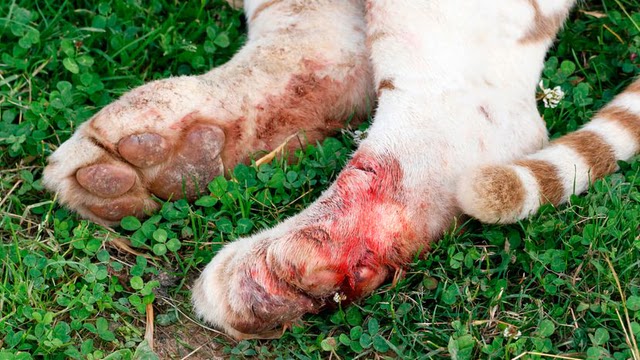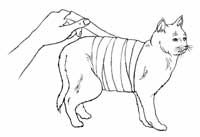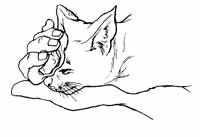Quck answer
If your cat is bleeding, it’s important to act quickly to prevent further injury or infection. Here are some steps you can take to treat a bleeding cat:
1. Apply pressure to the wound using a clean cloth or gauze.
2. Elevate the affected area if possible to slow down the bleeding.
3. Clean the wound with mild soap and water or saline solution.
4. Apply an antiseptic ointment and cover the wound with a sterile bandage.
5. Monitor your cat for signs of infection or worsening bleeding and seek veterinary care if necessary.
Remember, it’s always better to err on the side of caution and seek professional help if you’re unsure how to treat your cat’s injury.
Pets

As a pet owner, it’s important to know how to provide first aid to your cat in case of an injury. Christophe Lehenaff / Getty Images
One important aspect of cat care is learning how to treat a bleeding cat. The main objective of administering first aid to a bleeding cat is to prevent excessive blood loss that can lead to shock. Applying pressure to the wound enables the blood to clot and stop the bleeding. This is a complex process, but basically, the blood cells form a fine mesh over the wound, preventing further loss of blood. This is why it’s crucial not to remove the dressing once it’s been applied.
If your cat has internal bleeding, you may not be able to tell just by looking at it, and it may go into shock. Some signs of shock to look out for include pale or white gums, rapid heartbeat, and breathing. If the wound is spurting blood, it means an artery has been cut, and you should seek immediate professional attention.
The method you use to treat your cat will depend on the location and severity of the bleeding. The following cat care tips will guide you in providing first aid to various parts of the body.
Treating a Bleeding Head or Torso
Method A
Step 1: Approach your cat and, if necessary, restrain it if it’s anxious or scared.

В©2006 Publications International, Ltd. Method A, Step 3
Step 2: Cover the wound with a clean folded towel, sterile gauze pad, heavy cloth, or sanitary napkin.
Step 3: Wrap torn rags or other soft material around the dressing and tie or tape just tightly enough to hold in place.
Step 4: Take your cat to the veterinarian immediately.
Treating a Bleeding Leg, Paw, or Tail
Method B
Step 1: Approach your cat and, if necessary, restrain it if it’s anxious or scared.
Step 2: Clip the hair around the injured area.

В©2006 Publications International, Ltd. Method B, Step 3
Step 3: Examine the wound for glass or other foreign objects. If they’re visible, remove them with your fingers or tweezers. If the tissue under the wound appears to pass by when you move the skin, the wound will probably require stitches.
Step 4: Flush the wound thoroughly with clean water. Avoid using home antiseptics, which your cat will likely lick and which may cause pain when applied.
Step 5: Cover the wound with a clean cloth, sterile dressing, or sanitary napkin.
Step 6: Place your hand over the dressing and press firmly.
Step 7: Keep pressure on the dressing to stop the bleeding. If blood soaks through the dressing, do not remove it. Apply more dressing and continue to apply pressure until the bleeding stops. If the bleeding doesn’t stop within five minutes, continue to apply pressure on the wound while transporting your cat to the veterinarian.
Step 8: Wrap torn rags or other soft material around the dressing and tie or tape just tightly enough to keep it in place. Start below the wound and wrap upward.
Step 9: If the wound is deep enough to require stitches, keep your cat off the injured leg and transport it to the veterinarian immediately.
Cat’s Ear Bleeding
Method C
To start, approach the cat and restrain them if necessary, especially if they are anxious or scared. Then, cover the wound with a clean cloth, sterile dressing, or sanitary napkin. Cut ears may bleed profusely, so place the dressing material on both sides of the ear flap and hold firmly to control bleeding. After applying pressure, cats’ ears usually stop bleeding within five minutes.

©2006 Publications International, Ltd. Method C, Step 2
Cat’s Nail Bleeding
Method D
If a cat’s nail is bleeding, do not try to cut or remove the broken nail. Instead, approach the cat and restrain them if necessary. Then, unsheathe the claw on the cat and place your thumb on top of the paw, close to the nail, and your index finger on the large pad on the bottom of the paw. Press your thumb and finger together to expose the nail for examination. With the nail exposed, hold a clean cloth, sterile dressing, or sanitary napkin against the nail. Bleeding should stop in a few minutes. If the cat seems to be in severe pain or if bleeding does not stop, take them to the veterinarian as soon as possible to treat any bleeding disorder.
Cat’s Nose Bleeding
Method E
First, approach the cat and restrain them if necessary. Then, apply an ice pack to the top of the cat’s nose between its eyes and nostrils. Cover the bleeding nostril with a clean cloth, sterile dressing, or sanitary napkin and hold the cloth or dressing firmly on the cat until the bleeding stops. If the nostril was not cut, a bloody nose in a cat could indicate a serious disorder. Take the cat to the veterinarian as soon as possible to get proper treatment.

©Publications International, Ltd.
FAQ
1. What should I do if my cat is bleeding?
If you notice your cat is bleeding, the first step is to remain calm. Assess the area of bleeding and apply pressure with a clean cloth or gauze. If the bleeding is severe or doesn’t stop within a few minutes, it’s important to seek veterinary care immediately.
2. What are the most common causes of bleeding in cats?
Bleeding in cats can be caused by a variety of factors such as trauma, injury, or underlying medical conditions like infections, tumors, or blood clotting disorders. Ingestion of toxic substances or foreign objects can also cause bleeding in cats.
3. Can I give my cat pain medication for bleeding?
No, never give your cat any medication without consulting with a veterinarian first. Some human pain medications can be toxic to cats and make the bleeding worse.
4. How can I prevent my cat from bleeding?
Preventing bleeding in cats involves keeping them away from potential hazards like sharp objects, toxins, and other animals that may cause injury. Regular veterinary check-ups can also help detect underlying health issues that may lead to bleeding.
5. Is it safe to use home remedies for bleeding in cats?
No, it’s not recommended to use home remedies without consulting with a veterinarian. Some home remedies can make the bleeding worse or cause other complications.
6. What should I do if my cat’s bleeding won’t stop?
If your cat’s bleeding won’t stop, it’s crucial to seek veterinary care immediately. In the meantime, continue to apply pressure to the affected area until you can get to the vet.
7. How can I keep my cat calm during treatment for bleeding?
Cats can become anxious and scared during medical treatment, so it’s important to keep them calm. Try to create a peaceful environment with minimal noise and distractions. You can also use pheromone sprays or calming agents recommended by your veterinarian.
8. What is the prognosis for a cat with bleeding?
The prognosis for a cat with bleeding depends on the underlying cause and severity of the bleeding. With prompt veterinary care, many cats can recover from bleeding and go on to live happy, healthy lives.





Leave a Reply